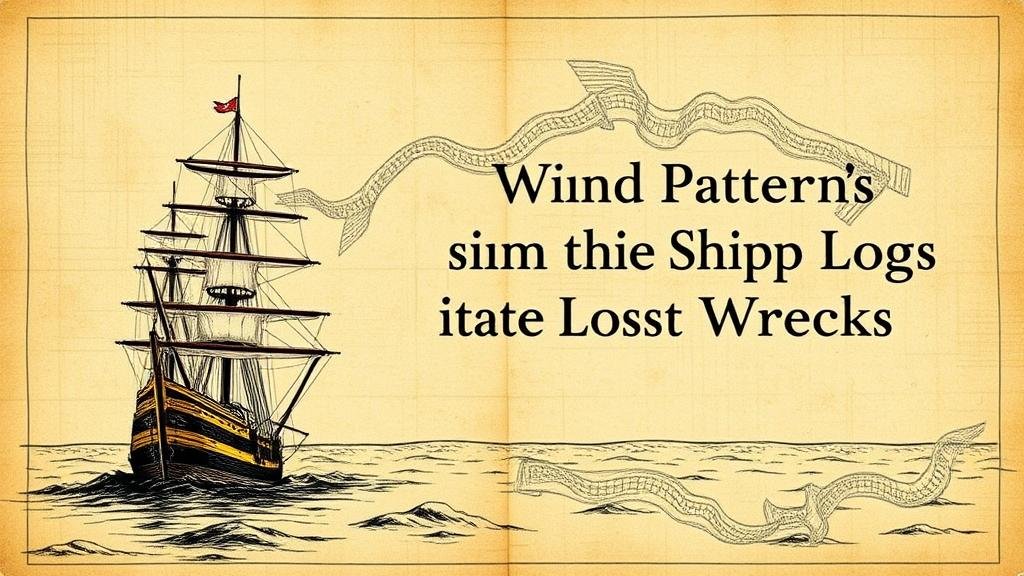How to Use Wind Patterns in Historical Ship Logs to Trace Lost Wrecks
How to Use Wind Patterns in Historical Ship Logs to Trace Lost Wrecks
The study of historical ship logs offers a unique perspective into maritime navigation and the environmental challenges faced by seafaring vessels. In particular, analyzing wind patterns recorded in these logs can facilitate the tracking of lost shipwrecks. This article explores the methodology behind this analysis, underscores its historical significance, and illustrates its application in maritime archaeology.
The Historical Context of Ship Logs
Ship logs, or journals maintained by captains and their crews, provide detailed records of voyages, including weather conditions, navigation routes, and cargo details. e logs date back to the early modern period, with notable examples such as the logs of Captain James Cook, which are crucial for reconstructing historical voyages. According to the Maritime Archaeology Journal, these documents contain invaluable data not only for navigation but also for understanding historical climatic conditions.
Understanding Wind Patterns
Wind patterns are a critical factor in maritime navigation, influencing the speed and direction of ships. In the field of meteorology, winds are primarily categorized into two types: prevailing winds and local winds. study of prevailing winds–systematic, long-lasting winds that dominate a region–is particularly useful for this analysis. For example, the trade winds, which blow from east to west in the tropics, can significantly affect a ships course over long distances.
According to historical data from the National Climatic Data Center, the typical strength and direction of these winds can be correlated with specific periods in history, allowing researchers to reconstruct sailing conditions experienced by historical vessels.
Methodology for Analyzing Ship Logs
Tracing lost wrecks using wind patterns from historical ship logs typically involves the following steps:
- Data Collection: Gather historical ship logs that include wind data. Resources include the Cornell University Library and various maritime museums.
- Data Standardization: Convert wind speed and direction recorded in logs to standard meteorological terms for consistency.
- Geographic Correlation: Map the origins and destinations of the voyages onto modern charts to assess potential wreck locations.
- Simulation and Modeling: Use computer models to simulate the ships journey under the recorded wind conditions. Tools like OpenStreetMap facilitate this process with layers representing historical data.
Case Studies
Numerous shipwrecks have been traced using this methodology, with significant findings enhancing our understanding of historical maritime activity. One notable case is the wreck of the HMS Endeavour, lost during the American Revolutionary War. By analyzing the wind patterns recorded in Captain Cooks logs, marine archaeologists were able to narrow down its possible location off the coast of Rhode Island.
Another example includes the disappearance of the merchant ship Mary Celeste in 1872. Researchers utilized the logs of nearby vessels, assessing wind patterns and sea conditions at the time of its disappearance, leading to hypotheses about its trajectory and eventual fate.
Challenges and Limitations
While this methodology is promising, it is not without challenges. One of the primary concerns is the inconsistency in recording practices over centuries. For example, early logs may lack precise wind measurements or use non-standardized terminology. reliability of historical weather data also poses a challenge; contemporary meteorological records may not accurately reflect past conditions.
Plus, the interpretation of logs requires a nuanced understanding of navigation and maritime practices from the relevant historical periods, necessitating interdisciplinary collaboration among historians, meteorologists, and archaeologists.
Conclusion and Future Directions
The integration of wind pattern analysis from historical ship logs presents a robust approach to tracing lost wrecks. With advancements in data analysis techniques and technology, this field holds considerable potential for uncovering maritime history. Further interdisciplinary research can enhance the robustness of these findings and provide a deeper understanding of the maritime context in which these ships operated.
Researchers and archaeologists are encouraged to pursue comprehensive analyses of existing ship logs while exploring advancements in simulation technologies to refine the accuracy of wreck location predictions. future of maritime archaeology may depend significantly on mastering the winds of history.



